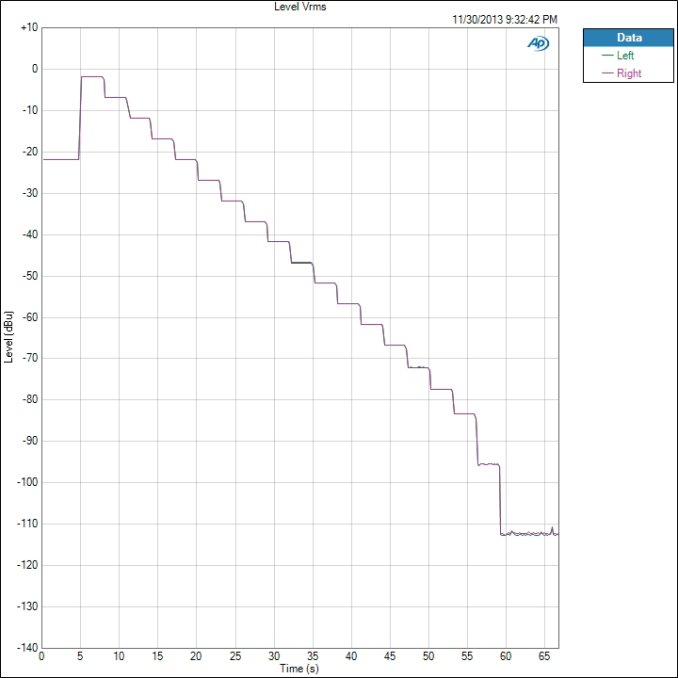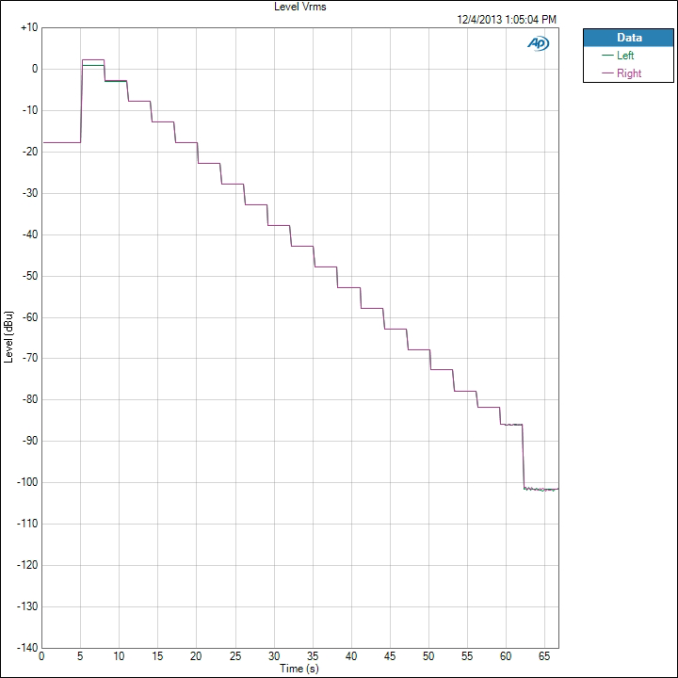Smartphone Audio Quality Testing
by Chris Heinonen on December 8, 2013 5:15 PM EST- Posted in
- Smartphones
- Audio
- Mobile
- Tablets
- Testing
Dynamic Range
The dynamic range of the phone indicates the difference between the loudest possible sound and the background noise. The more residual noise in the background, the lower the dynamic range. Phones with more powerful amplifier sections will typically produce a greater dynamic range. The residual noise level is often constant, so as the overall volume level increases the difference between the music and the noise increases as well.
The best performer here is the iPhone 5 again, with 92.214 dB of range. The worst is the Nexus 5 with only 89.332 dB. A difference of 3 dB is not something I would concern myself over. If we see a phone or tablet that drops down below 80 dB then I will start to show more concern.
Crosstalk
Crosstalk, like dynamic range, is just a number here. This is the measurement how much signal leaks from one channel into another. If an instrument should only be in the right ear, some of that signal will leak into the left ear, but we want that as low as possible. The results are expressed in -dB, or how much quieter one ear is than the intended ear.
On the Note 3 we see a wonderful crosstalk measurement of -117.2 dB so the sounds in one ear are -117 dB quieter in the other ear. This makes them impossible to hear. The worst is the iPhone 5, with only -75.624 dB of isolation.
Stepped Response
The stepped response uses a 1 kHz 0 dBFS tone but measures output level from maximum volume to minimum volume. We can see how large the volume steps are and how many there are. It doesn’t produce a number we can use, but it ties back into our other results. For a good example, we can look at the Note 3.
We see steps that are around -5 dBu each. The final level is muted and just the background noise of the device. Each step is clean and even but as we get lower and lower we see noise start to intrude. This is the background noise starting to become audible in the signal. The flatter the levels are, the quieter it will be. Now, let us look at the Nexus 5.
Notice at the very top how the right and left channels do not overlap. That is the clipping we talked about at the very beginning. It isn’t until the 4th volume setting that the level difference is down to nothing. Because of this, I would consider the top 3 volume settings of the Nexus 5 as ones that should be avoided. They each have enough THD+N introduced into them that it will sound poor, and one ear will be louder than the other.












188 Comments
View All Comments
Impulses - Monday, December 9, 2013 - link
Ehh, impedance curves for the headphones he suggested (Grado SR80, AKG K701) are easy to find (Inner Fidelity and others have decent databases)... Testing and providing output impedance for the phones would be very valuable indeed though, even if everything else in the chain performs alright that alone can affect the FR significantly with one pair of headphones and not at all with the next... And unfortunately there's never been a realistic standard for output impedance, (other than high quality solid state amps now aiming for >1 ohm), and it's often all over the place.ssddaydream - Monday, December 9, 2013 - link
I agree with this.I think of three main usage scenarios regarding the headphone output:
1.) Quality of HP output driving a high-impedance line-level input for a home or car stereo.
2.) Quality of HP output driving low-impedance, sensitive IEMs.
3.) Quality of HP output driving high-impedance, non-sensitive cans.
For #2 and #3, the output impedance should be known, as well as the amplifier power at a given THD level.
There reasons why the iPhones are able to perform well with IEMs, namely low noise floor and low output impedance. Also, iPhones perform well with larger cans because of the decent output power.
I think the usage cases I listed above are pretty common, so I think a good approach to testing is to think about the most important parameters for each usage case.
BTW, I am excited about AT doing these measurements- very good news, indeed!
Anand_user123 - Monday, December 9, 2013 - link
I use my phone most of the time as a music player. Audio quality and storage capacity for flac files are major factors in my buying decision. I hope we can have more widespread information on smartphones audio performancestepz - Monday, December 9, 2013 - link
If you actually cared about scientific measurements of audio performance you would use compressed audio instead of flac. ;) Given a decent amount of bitrate, compressed audio is indistinguishable from uncompressed in double blind tests. In my experience FLAC is mostly about the listener feeling good about getting the "correct" experience, like expensive speaker cables.Impulses - Monday, December 9, 2013 - link
There's a valid usage case for FLAC as far as ripping and archiving IMO, you might as well if you're ripping a large collection (or ripping often)... Since you can quickly re-transcode or edit files w/o a loss of quality... But yeah, I don't see why anyone would put FLAC files on a phone, transcoding is dead simple and super quick if you have a remotely modern PC. Managing FLAC & MP3 playlists or whatever shouldn't be a hurdle if you're putting the effort to maintain a FLAC library to begin with, just use the MP3 library for everything or use stuff like Media Monkey's smart filters/playlists.NaterGator - Monday, December 9, 2013 - link
The biasing of the amplifier in the Nexus 5 and LG G2 left channel appears incorrect. Note it is only clipping on the negative portion of the waveform.vshah - Monday, December 9, 2013 - link
Can't wait to see htc one results!jrs77 - Monday, December 9, 2013 - link
Could you compare the phones to an iPod maybe? This way we would've an comparisooon to a mediaplayer where there's no 3G/4G/LTE disturbance.Oh, and for the general audience discussing the DACs etc... The DAC isn't the cruicial part, never has been. The amp is what it's all about and how good or poor it's powered.
There's a reason why audiophiles still use tube-amps, or atleast digital amps with high quality toroidal transformers and good shielding to reduce noise distortion etc.
Oh, and btw... A good mediaplayer needs a microSDHC-slot or the possibility to use an USB-stick. A mediaplyer is no good if I can't carry my whole music-library with it (100+ GB).
Leezhunjin - Monday, December 9, 2013 - link
Hi Chris, very nice to see smartphones getting measured in terms of audio performance, as many of these phones are used as a music device as well. Personally, I think that an inclusion of output impedance measurements would really great be though, as it is one of the factors that would affect the earphone performance rather significantly.CSMR - Monday, December 9, 2013 - link
Very good start. Poor quality needs to be exposed and you've done this with the Nexus 5.I would like to see output impedance since low output impedance is a very important quality of a good headphone output.